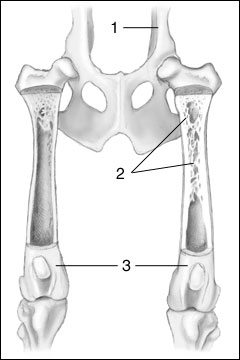Panosteitis
- Short Description
- Panosteitis, eosinophilic panosteitis Panosteitis, growing pains in dog bones
- Affected Animals
- Overview
- Rapidly growing dogs may experience pain that arises from the long bones in the limbs. These "growing pains" are known clinically as panosteitis, a disease affecting young dogs between the ages of five to 12 months. Lameness that shifts from leg to leg is a common symptom of panosteitis. Nausea and fever may occur as well. Although the pain associated with panosteitis can be acute, this discomfort -- along with the other symptoms -- almost always goes away once the dog has matured.Large breeds, particularly the German shepherd, are most commonly affected by panosteitis, which also is reported fairly frequently in the golden and Labrador retriever, Great Dane, Scottish terrier, and Doberman pinscher breeds.
- Clinical Signs
- Long bone pain, shifting leg lameness, fever, anorexia, lethargy.
- Symptoms
- Lameness that may shift from limb to limb, pain, fever, and loss of appetite.
- Description
- Affecting young, rapidly growing dogs of larger breeds, panosteitis is a disease that causes inflammation in the marrow cavities of long bones such as the humerus, radius, ulna, femur, and tibia. This inflammation leads to pain and the production of reactive bone that results in lameness and sometimes fever.

- Pelvis
- Lesions of Panosteitis
- Femur
Because it can affect different bones at different times, frequently the lameness will "shift" from limb to limb. These cycles of lameness may last from two to three weeks for each affected bone. Often, there will be periods of apparent normalcy between the periods of lameness. Fortunately, although very painful, the disease usually disappears when the dog reaches maturity. - Diagnosis
- The veterinarian may presume a diagnosis if the dog shows signs of the disease and is a commonly affected large breed. A definitive diagnosis requires x-rays. However, x-rays taken early in the course of the disease may not always demonstrate the lesions; thus it may be necessary to repeat x-rays on the dog two weeks later. In repeat x-rays, the characteristic changes often will be present.
- Prognosis
- Prognosis is excellent, as most dogs recover with no permanent effects. Occasionally, panosteitis will flare up in mature dogs, but this is quite unusual. Some dogs can, however, be in extreme pain and it may be difficult to keep them comfortable while the disease is active.
- Transmission/Cause
- The cause of panosteitis is unknown. There is speculation that it may be viral, and distemper has been implicated as a potential cause, but this relationship has yet to be proven conclusively. Other possible causes include nutritional derangements, immunologic disease, metabolic disease, and other viruses.
- Treatment
- Panosteitis is treated symptomatically. Rest, exercise restriction, and pain medication are prescribed. Pain medication is usually a non-steroidal anti-inflammatory drug, or NSAID, such as aspirin, etodolac, or carprofen. Rarely, severely affected dogs may need more potent pain relief such as narcotic drugs.
- Prevention
There is no specific method of prevention; however, many veterinarians believe the disease is made worse by calorie-dense diets and over-supplementation with calcium and phosphorus. Thus, a diet change to an adult formula, or a large breed growth formula, is recommended. The dog should be fed an amount that does not promote obesity or overly rapid growth. Calcium and vitamin supplements should also be avoided.
